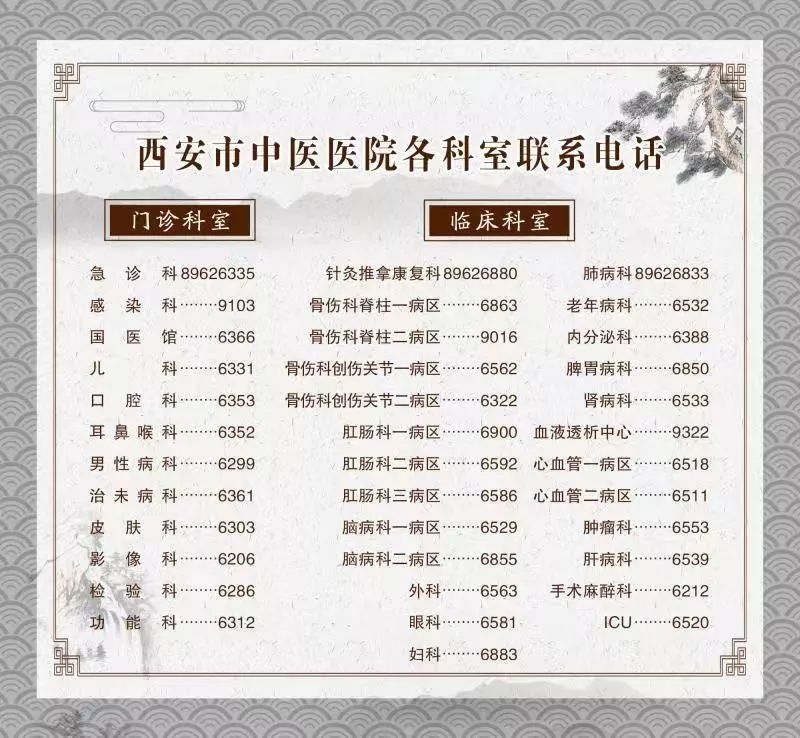
Due to the recent impact of the COVID-19 pandemic, everyone has had to reduce outings and stay at home, which can lead to “internal injuries”. In light of this situation, I would like to recommend a suitable exercise method for home, which can not only help regulate and improve one’s negative psychological state but also enhance the function of the internal organs, improve physical fitness, and strengthen the ability to prevent and resist diseases.At this point, I must introduce to you the gem of traditional Chinese health culture—Baduanjin Qigong.Baduanjin Qigong is a complete and independent set of fitness exercises that originated in the Northern Song Dynasty and has been passed down for over a thousand years. It combines physical movements, breathing techniques, and psychological adjustments, making it a traditional national exercise method. Due to its significant and safe fitness effects, it has been widely practiced among the people for over a thousand years and is loved by the masses. Practical experience shows that regular practice of Baduanjin is highly beneficial for the body.How much do you know about this traditional exercise method?Baduanjin is one of the common fitness methods of ancient times. It consists of eight main movements, hence the name “Baduanjin”. The “eight” in Baduanjin not only refers to the eight movements but also implies that the method encompasses various elements that mutually restrict, connect, and circulate.The movements of this method are ancient and elegant, characterized by “gentle and slow, round and continuous; combining relaxation and tension, integrating movement and stillness; harmonizing spirit and form, with qi embedded within.” The postures can be performed in both sitting and standing positions. By stretching the limbs in coordination with breathing, one can adjust the mind, breath, and body. Long-term practice can balance yin and yang, harmonize qi and blood, unblock meridians, cultivate vital energy, and invigorate the righteous qi, thus achieving health preservation, strengthening the body, dispelling evils, and preventing and treating diseases. The standing form of Baduanjin is particularly easy for the public to practice, hence its widespread popularity.
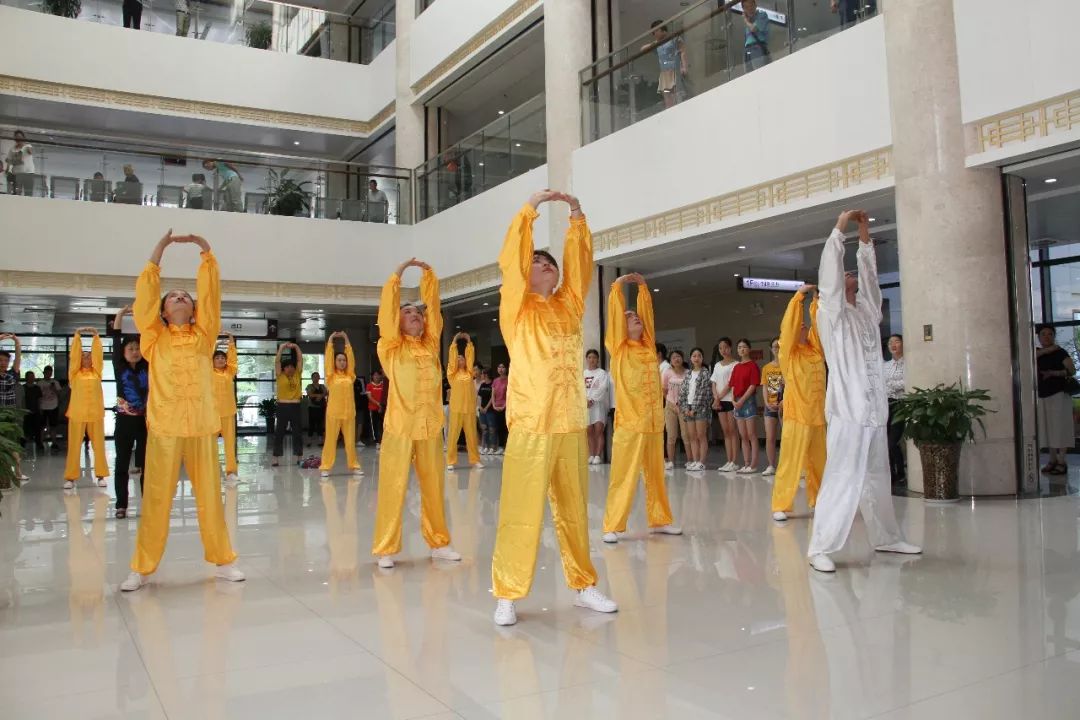
The key points of the Baduanjin movements can be summarized in eight phrases:Two hands hold up the heavens to regulate the Sanjiao (Triple Burner); left and right open the bow like shooting an eagle;To regulate the spleen and stomach, one must lift one hand; the five fatigues and seven injuries look back;Shake the head and wag the tail to dispel heart fire; two hands grasp the feet to strengthen the kidneys and lower back;Clench the fists and glare to increase strength; seven bounces behind the back dispel all diseases.Practicing “Baduanjin” can be divided into 3 stages:First Stage: Learn the postures, aiming for their appearance, which is essential and serves as the entry point.Second Stage: Strengthen the muscles and bones, and unblock qi and blood. The practice requires that each posture must be performed correctly. For example, in the first movement, when holding up the heavens to regulate the Sanjiao, the hands must slowly stretch straight up, and after reaching full extension, one should apply subtle strength to ensure that all the muscles and bones are fully extended, which is considered correct.Third Stage: Unblock qi and blood, allowing qi and blood to circulate throughout the body, gradually clearing any obstructed meridians. This stage is the most challenging and the most important. If this stage is done well, one will feel a fullness of qi throughout the body after completing “Baduanjin”, with a particularly noticeable sensation in the hands.

Next, I will detail the key points and principles of each Baduanjin movement. First Movement:Two Hands Hold Up the Heavens to Regulate the SanjiaoKey Points: Stand with feet shoulder-width apart. Interlace fingers in front of the abdomen with palms facing up, raise both palms to chest level, then flip palms and continue raising them above the head, lifting the head to look at the hands as they pass the face. At the peak, separate the hands and slowly lower them from the sides while looking forward. One up and down counts as one repetition, perform 8 repetitions.
First Movement:Two Hands Hold Up the Heavens to Regulate the SanjiaoKey Points: Stand with feet shoulder-width apart. Interlace fingers in front of the abdomen with palms facing up, raise both palms to chest level, then flip palms and continue raising them above the head, lifting the head to look at the hands as they pass the face. At the peak, separate the hands and slowly lower them from the sides while looking forward. One up and down counts as one repetition, perform 8 repetitions.
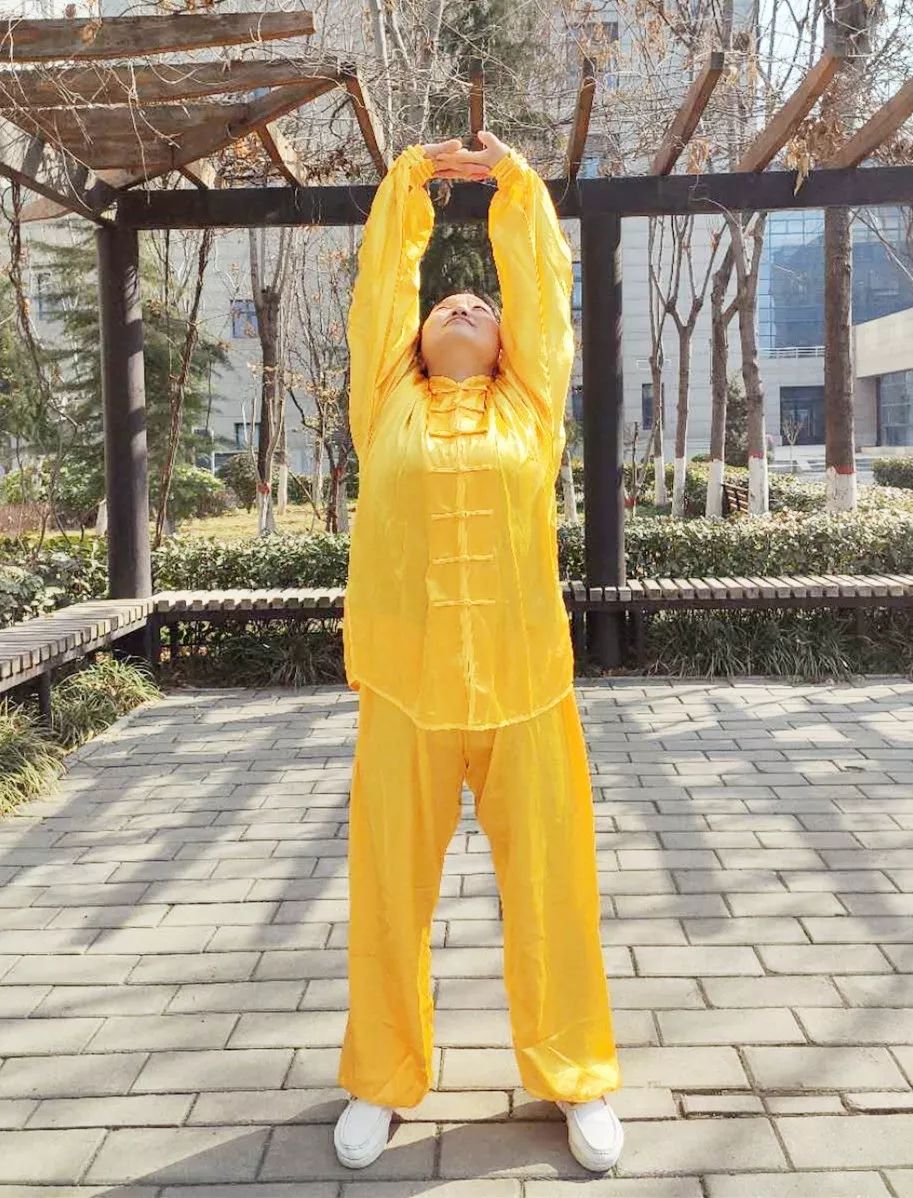
Effects and Principles:This movement, by raising both hands, applies gentle force while maintaining a stretch and deep breathing, allowing the entire torso to fully extend and massage the internal organs, stimulating the meridians such as the hands, feet, and Renmai (Conception Vessel). Since these meridians run through the chest, abdomen, neck, and arms, they form a circular flow, thus unblocking the internal organs and their associated meridians and skin areas. Additionally, the stretching of the spine can activate the Du Mai (Governing Vessel) and the bladder meridian on both sides of the spine. Since the “Du Mai is the sea of yang meridians”, and the bladder meridian is a yang meridian running through the back, it has points related to the five zang and six fu organs, thus promoting the generation of yang qi in the body. Stretching the torso and the muscles, ligaments, and soft tissues around the joints can effectively prevent and treat shoulder issues and cervical spondylosis. Stretching is a natural action for humans, and many animals exhibit similar movements. The key to this movement is that when the hands are raised, the head should also tilt back, and the eyes should focus on the hands. This helps to relax the neck, which is often bent down during work. Moreover, the internal organs, when suspended for too long, tend to sag. Raising the arms and stretching can elevate the internal organs. Second Movement:Left and Right Open the Bow Like Shooting an EagleKey Points: Shift the body weight to the right; step left with the left foot; keep the knees naturally straight; at the same time, cross the palms at chest level with the left palm on the outside, palms facing inward; look forward. Gradually bend the knees into a horse stance; simultaneously, curl the right hand into a claw and pull it to the front of the shoulder; the left palm forms a “八” shape, with the left arm internally rotated, pushing outward to shoulder height, palm facing left, resembling the action of drawing a bow; pause slightly and look in the direction of the left palm. Shift the body weight to the right; at the same time, extend the right hand with fingers spread, drawing an arc upward and to the right, at shoulder height, fingers pointing up, palm facing slightly forward; the left hand also spreads with palm facing slightly backward; look at the right palm. Continue shifting the weight to the right; bring the left foot back to a standing position; simultaneously, lower the palms from the sides. Repeat the above actions, mirroring left and right. One left and one right counts as one repetition, perform 4 repetitions.
Second Movement:Left and Right Open the Bow Like Shooting an EagleKey Points: Shift the body weight to the right; step left with the left foot; keep the knees naturally straight; at the same time, cross the palms at chest level with the left palm on the outside, palms facing inward; look forward. Gradually bend the knees into a horse stance; simultaneously, curl the right hand into a claw and pull it to the front of the shoulder; the left palm forms a “八” shape, with the left arm internally rotated, pushing outward to shoulder height, palm facing left, resembling the action of drawing a bow; pause slightly and look in the direction of the left palm. Shift the body weight to the right; at the same time, extend the right hand with fingers spread, drawing an arc upward and to the right, at shoulder height, fingers pointing up, palm facing slightly forward; the left hand also spreads with palm facing slightly backward; look at the right palm. Continue shifting the weight to the right; bring the left foot back to a standing position; simultaneously, lower the palms from the sides. Repeat the above actions, mirroring left and right. One left and one right counts as one repetition, perform 4 repetitions.
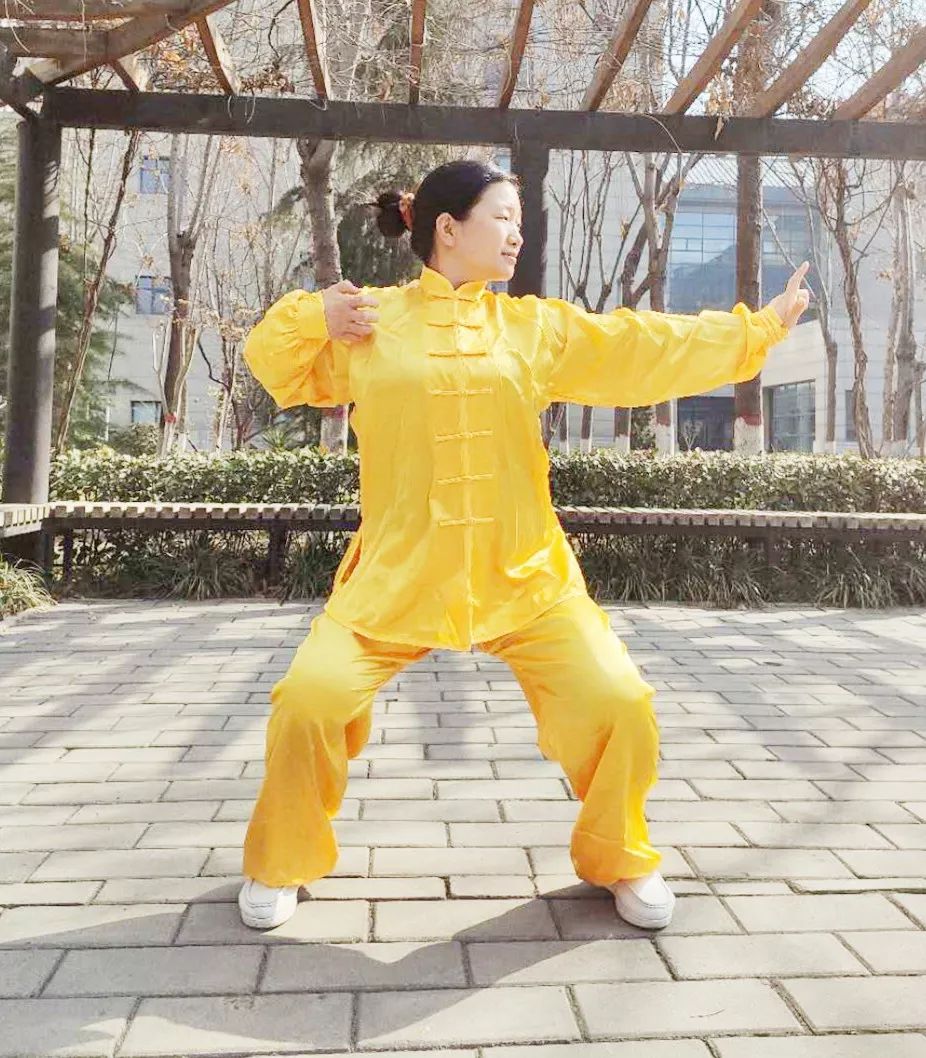
Effects and Principles:This movement primarily involves shoulder expansion and chest opening, stimulating the Du Mai, the three yin and three yang meridians of the hands, and the back shu points. It can regulate the qi of the hand taiyin lung meridian and the hand shaoyin heart meridian. Effectively corrects poor postures such as hunching and shoulder internal rotation, preventing shoulder and neck diseases. The repeated transitions into horse stance can effectively develop lower limb muscle strength, improve balance and coordination, and increase the strength of the forearm and hand muscles, enhancing the flexibility of the wrist and finger joints. The continuous shifting of weight between the feet exercises the muscles of the waist, hips, and legs. The upward extension of the head and the downward sinking of the tailbone elongate the spine, which can prevent and treat spinal diseases. The stretching of the left arm and the pulling of the right arm can loosen the joints of the chest and arms, allowing for full expansion of the chest, thus regulating the functions of the heart and lungs. The left hand’s “八” shape stimulates the Laogong point in the palm, which can stretch the lung and large intestine meridians. Furthermore, this yin-yang opposing and unifying posture can help the body achieve stability and balance, significantly enhancing stability and balance capabilities. By focusing on the thumb’s Shangyang point, one can stimulate the large intestine meridian, which in turn affects the lung meridian, achieving regulation of the heart and lungs. Additionally, gripping the ground with the toes can stimulate the spleen and stomach meridians, enhancing digestive function. Third Movement:To Regulate the Spleen and Stomach, One Must Lift One HandKey Points: Raise the left palm, rotating the left arm outward and lifting it above the head to the left, with a slight bend in the elbow, applying force to the base of the palm, palm facing up and fingers pointing right; at the same time, the right palm is slightly raised, then rotated inward and pressed down to the right hip, with a slight bend in the elbow, applying force to the base of the palm, palm facing down and fingers pointing forward, pausing slightly; look forward. Relax the waist and sink the hips, gradually lowering the body weight; slightly bend the knees; at the same time, bend the left arm at the elbow, rotating it outward, allowing the left palm to drop in front of the abdomen, palm facing up; the right arm rotates outward, lifting the right palm in front of the abdomen, with the fingertips facing each other, about 10 centimeters apart, palms facing up; look forward. Repeat the above actions, mirroring left and right. One left and one right counts as one repetition, perform 4 repetitions.
Third Movement:To Regulate the Spleen and Stomach, One Must Lift One HandKey Points: Raise the left palm, rotating the left arm outward and lifting it above the head to the left, with a slight bend in the elbow, applying force to the base of the palm, palm facing up and fingers pointing right; at the same time, the right palm is slightly raised, then rotated inward and pressed down to the right hip, with a slight bend in the elbow, applying force to the base of the palm, palm facing down and fingers pointing forward, pausing slightly; look forward. Relax the waist and sink the hips, gradually lowering the body weight; slightly bend the knees; at the same time, bend the left arm at the elbow, rotating it outward, allowing the left palm to drop in front of the abdomen, palm facing up; the right arm rotates outward, lifting the right palm in front of the abdomen, with the fingertips facing each other, about 10 centimeters apart, palms facing up; look forward. Repeat the above actions, mirroring left and right. One left and one right counts as one repetition, perform 4 repetitions.
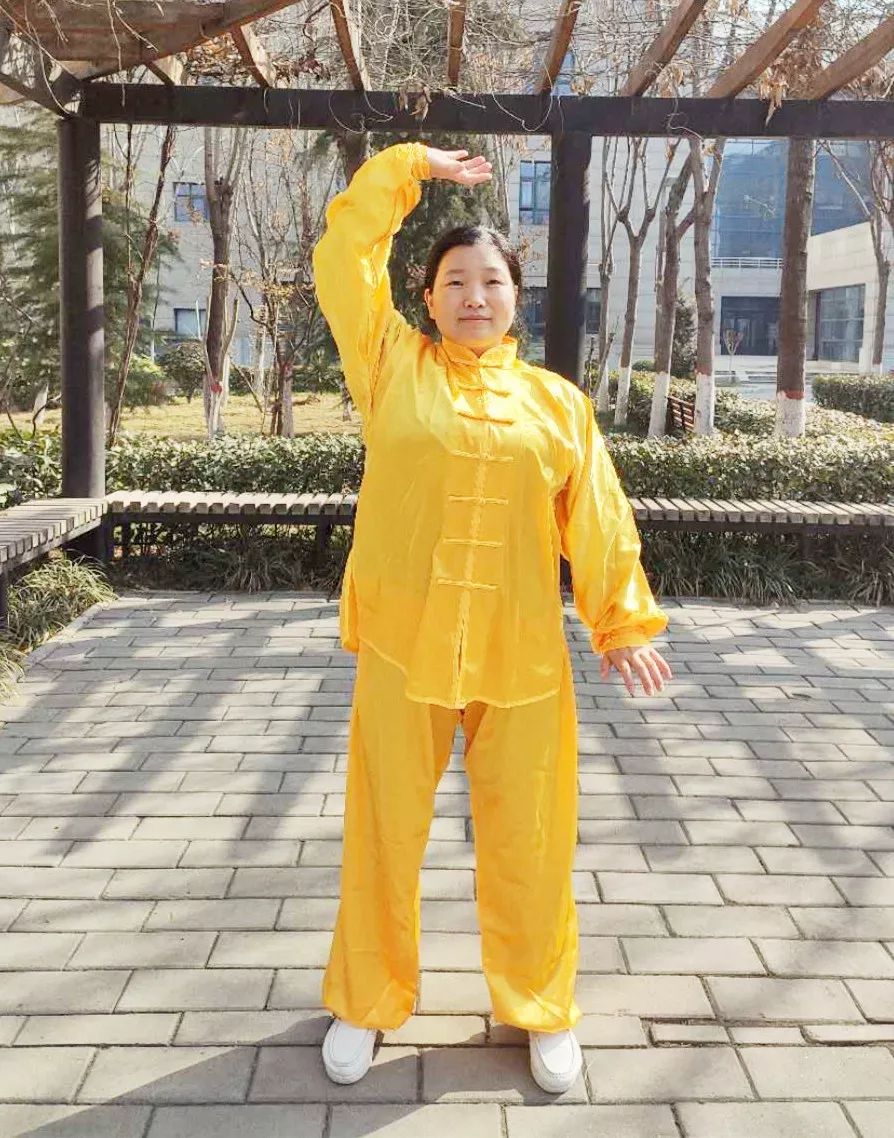
Effects and Principles: Traditional Chinese medicine holds that the spleen is the official of storage, responsible for the transformation and transportation of food and water. The stomach is the great storage, primarily responsible for receiving and ripening food. The spleen and stomach are interdependent, working together to digest and absorb food, and are referred to as the foundation of postnatal life. Additionally, the spleen and stomach are the pivot for the rise and fall of qi. The spleen promotes generation, while the stomach is responsible for harmony and descent. This movement, with one palm lifting and the other pressing down, exerts a compressive and stretching effect on the middle jiao (the area of the spleen and stomach), promoting the spleen’s ascent and the stomach’s descent. The alternating tension and relaxation of the upper limbs create static stretching, which can massage the spleen, stomach, liver, and gallbladder. It also stimulates related meridians in the abdomen and chest, as well as the back shu points, achieving regulation of the spleen, stomach, and internal organ meridians. This can enhance the flexibility and stability of the spine, benefiting the prevention and treatment of shoulder and neck diseases. Fourth Movement:Look Back to Address the Five Fatigues and Seven InjuriesKey Points: Extend both arms straight, palms facing backward, fingers pointing down, fully externally rotate, palms facing outward; turn the head to the left and pause slightly; look at the left diagonal back. Internally rotate both arms and press them at the hips, palms facing down, fingers pointing forward; look forward. Repeat the above actions, mirroring left and right. One left and one right counts as one repetition, perform 4 repetitions.
Fourth Movement:Look Back to Address the Five Fatigues and Seven InjuriesKey Points: Extend both arms straight, palms facing backward, fingers pointing down, fully externally rotate, palms facing outward; turn the head to the left and pause slightly; look at the left diagonal back. Internally rotate both arms and press them at the hips, palms facing down, fingers pointing forward; look forward. Repeat the above actions, mirroring left and right. One left and one right counts as one repetition, perform 4 repetitions.
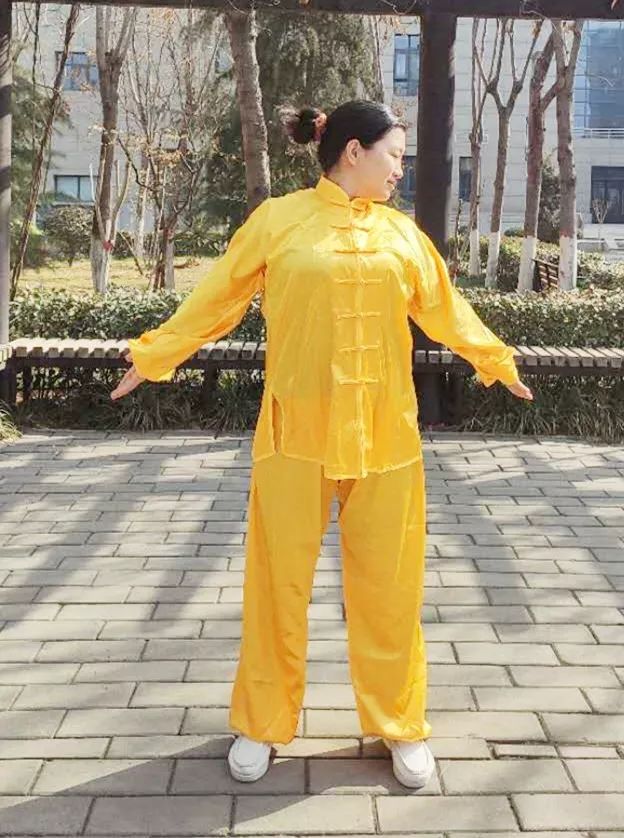
Effects and Principles:The five fatigues have two interpretations. One refers to the five internal organs being overworked, namely lung fatigue, liver fatigue, heart fatigue, spleen fatigue, and kidney fatigue. The second comes from the “Suwen (Plain Questions) · Xuanming Wuqipian (On the Five Qi)” which states: “The five fatigues cause injury; prolonged viewing injures blood, prolonged lying injures qi, prolonged sitting injures flesh, prolonged standing injures bones, prolonged walking injures tendons.” These are factors that lead to illness due to overwork. The seven injuries refer to the emotional injuries caused by joy, anger, sadness, worry, fear, shock, and thought. The five fatigues refer to physical aspects, while the seven injuries refer to emotional aspects. Here, the five fatigues and seven injuries can be understood as referring to all factors that lead to illness due to excessive physical and mental exertion. This movement, through the static stretching of the upper limbs, can expand and stretch the internal organs within the chest and abdomen. The backward turning of the head allows for full stretching and contraction of the neck muscles, stimulating the Dazhui point, which is essential for mental clarity and smooth functioning of the internal organs. Simultaneously, the shoulder joints are fully abducted, and the eye muscles are activated, achieving the goal of preventing and treating the “five fatigues and seven injuries”. It also helps prevent eye muscle fatigue and diseases of the shoulders, neck, and back, while improving blood circulation in the neck and brain, aiding in relieving central nervous system fatigue.
Fifth Movement:Shake the Head and Wag the Tail to Dispel Heart Fire
Key Points: Shift the body weight to the left, step right with the right foot; keep the knees naturally straight; at the same time, raise both palms to chest level, with both arms internally rotated, continuing to raise the palms above the head, with a slight bend in the elbows, palms facing up, fingertips facing each other; look forward. Gradually bend the knees into a horse stance; simultaneously, lower both arms to the sides, placing the palms above the knees, with a slight bend in the elbows, little fingers facing forward; look forward. The body weight rises slightly, then shifts to the right; the upper body leans to the right, then bends forward; look at the right foot. The upper body remains in motion. The body weight shifts to the left; at the same time, the upper body rotates from right to front, then to the left; look at the right foot. The body weight shifts to the right, forming a horse stance; simultaneously, the head shakes back, the upper body rises, and the chin slightly retracts; look forward. Repeat the above actions, mirroring left and right. After completing three repetitions, shift the body weight to the left, bringing the right foot back to a shoulder-width stance; simultaneously, raise both palms outward, palms facing each other; look forward. Then relax the waist and sink the hips, gradually lowering the body weight. Slightly bend the knees; at the same time, bend the elbows, pressing the palms down to the abdomen, palms facing down, fingertips pointing forward; look forward.

Effects and Principles: Heart fire is a term in traditional Chinese medicine referring to the condition of excessive heart heat, where the mechanism involves internal yang heat leading to symptoms such as mouth sores and insomnia. Under normal physiological conditions, kidney yin (or kidney water) can restrain heart yang, while heart yang can descend to the kidneys, warming the kidney water. This state is known as the harmonious interaction of water and fire, which is also described in qigong as “Kan Li Xiang Jiao”. When the heart and kidneys interact harmoniously, the condition of excessive heart fire does not occur. The purpose of this movement is to use kidney water to dispel heart fire. The upper body remains straight like an axis, allowing the spine to be exercised, and through the bending and shaking, the internal organs suspended from the spine are exercised, facilitating the flow of qi and blood, achieving the harmonious interaction of heart and kidneys, and the balance of water and fire. The shaking of the tailbone stimulates the kidney water to rise, achieving the interaction of heart and kidneys. Additionally, shaking the head can stimulate the Dazhui point, thus achieving the purpose of unblocking the meridians and dissipating heat, helping to eliminate heart fire. During the shaking of the head and tail, the lumbar and cervical regions undergo significant lateral bending, rotation, and twisting, engaging the head, neck, lumbar, and hip muscle groups, which increases the flexibility of the neck, waist, and hips while enhancing the strength of these areas.
Sixth Movement:Two Hands Grasp the Feet to Strengthen the Kidneys and Lower Back
Key Points: Stand with legs straight and knees extended; at the same time, extend both arms forward with fingertips pointing forward, raising them upward, elbows straight, palms facing forward; look forward. Rotate the arms outward until the palms face each other, bend the elbows, pressing the palms down to chest level, palms facing down, fingertips pointing toward each other; look forward. Rotate the arms outward again, palms facing up, then insert the palms under the armpits; look forward. Move the palms down along the sides of the spine to the hips; then bend forward, continuing to move the palms down along the back of the legs to the feet; lift the head, pausing slightly; look down. One up and down counts as one repetition, perform 8 repetitions. After completing 8 repetitions, stand upright; at the same time, raise both arms forward and upward, elbows straight, palms facing forward; look forward. Then relax the waist and sink the hips, gradually lowering the body weight; slightly bend the knees; at the same time, press the palms down to the abdomen, palms facing down, fingertips pointing forward; look forward.
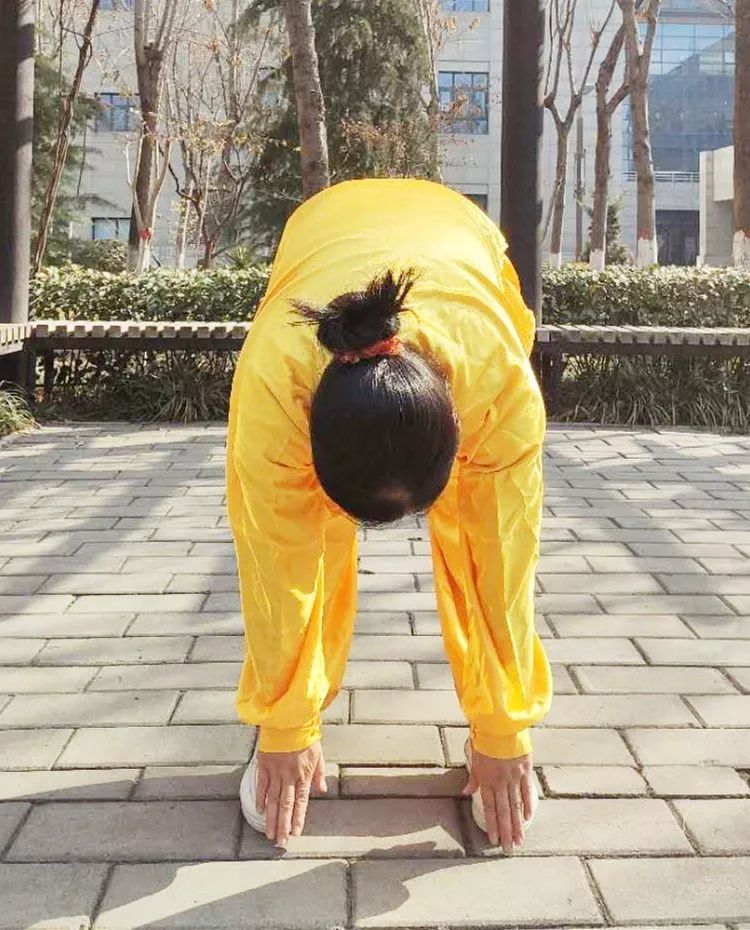
Effects and Principles: Traditional Chinese medicine believes that the kidneys are the foundation of human life, containing true yin and true yang, and are the source of vital energy. The balance of kidney yin and yang is fundamental to human growth and development, and the vitality of the kidneys directly relates to growth, development, and aging. This movement, through the active raising of both hands, helps to lift the upper body, and through the downward motion, bending the knees, pressing the palms on the feet, and lifting the head, primarily aims to unblock the meridians. The forward bending and backward stretching effectively stimulate the spine, Du Mai, as well as points such as Mingmen, Yangguan, and Weizhong, regulating the qi of the kidney, bladder, and Du Mai, achieving the effect of unblocking the meridians, promoting the flow of qi and blood, and mobilizing the waist joints and muscles. This helps to harmonize the qi and blood in the lumbar meridians, thus preventing and treating lower back pain. Additionally, through focused breathing and guiding activities, it acts on the Mingmen point, mobilizing internal qi, promoting smooth flow of qi and blood in the meridians, expelling evils, and nourishing the joints, muscles, and tissues of the waist, thus achieving the goal of treating diseases when present and preventing them when absent. Therefore, it is evident that the movement of two hands grasping the feet to strengthen the kidneys and lower back is an exercise method for strengthening the kidneys and treating lower back pain. This movement also helps prevent and treat chronic diseases of the reproductive and urinary systems, achieving the effect of strengthening the kidneys and lower back. The significant forward and backward bending of the spine effectively develops the strength and flexibility of the trunk’s flexor and extensor muscles, while also providing good stretching and massage to the kidneys, adrenal glands, and ureters, improving their function and stimulating their activity.
Seventh Movement:Clench the Fists and Glare to Increase Strength
Key Points: Shift the body weight to the right, step left with the left foot; gradually bend the knees into a horse stance; at the same time, clench both fists at the waist, with the fist openings facing up; look forward. Slowly thrust the left fist forward to shoulder height, with the fist opening facing up; glare, looking in the direction of the left fist; internally rotate the left arm, transforming the fist into a palm, with the tiger mouth facing down; look at the left palm. Externally rotate the left arm, with a slight bend in the elbow; at the same time, wrap the left palm around, turning the palm upward and gripping firmly; look at the left fist. Bend the elbow, retract the left fist to the waist, with the fist opening facing up; look forward. Repeat the above actions, mirroring left and right. One left and one right counts as one repetition, perform three repetitions. After completing three repetitions, shift the body weight to the right, bringing the left foot back to a standing position; simultaneously, transform both fists into palms, letting them hang naturally at the sides; look forward.
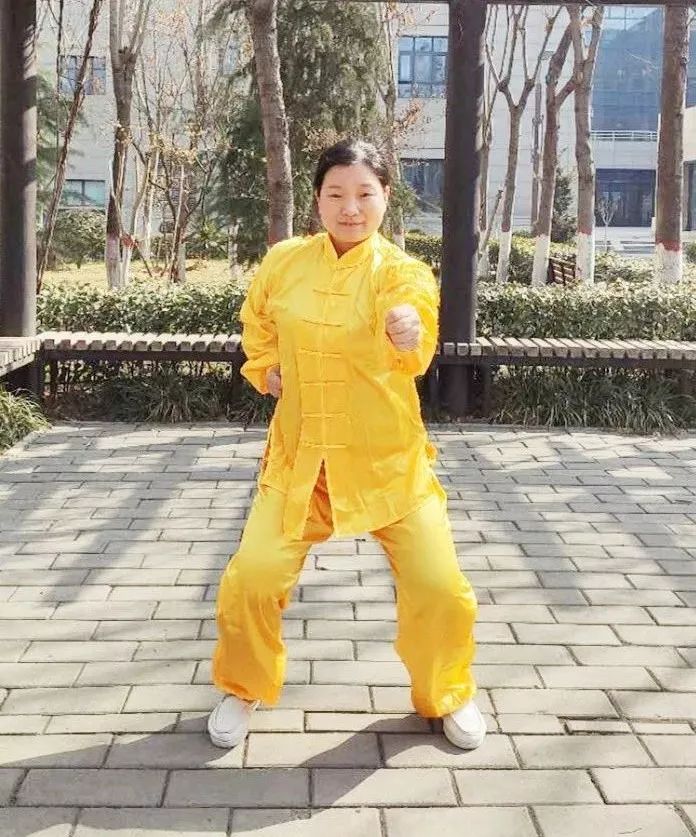
Effects and Principles: Traditional Chinese medicine holds that the liver governs the tendons and opens to the eyes, with its essence manifesting in the nails. The movements in this exercise are all related to the liver. The liver is known as the general’s organ, also referred to as the tough organ, which prefers smoothness and dislikes repression. Glare and intense gazing can help to disperse liver qi and enhance the liver’s righteous qi, aiding in emotional regulation. The squatting position with toes gripping the ground, clenching the fists, rotating the wrists, and forcefully gripping the fingers stimulate the points of the three yin and three yang meridians of the hands and feet, as well as the Du Mai. Simultaneously, the thrusting and retracting of the fists create strong static stretching throughout the body, which can effectively increase muscle mass and strength over time.
Eight Movement:Seven Bounces Behind the Back Dispels All Diseases
Key Points: Inhale, raise the heels while tightening the anus; lift the head upward, looking forward, holding for 3 seconds; lower the heels, lightly shaking the ground while exhaling; look forward. One rise and fall counts as one repetition, perform 7 repetitions.
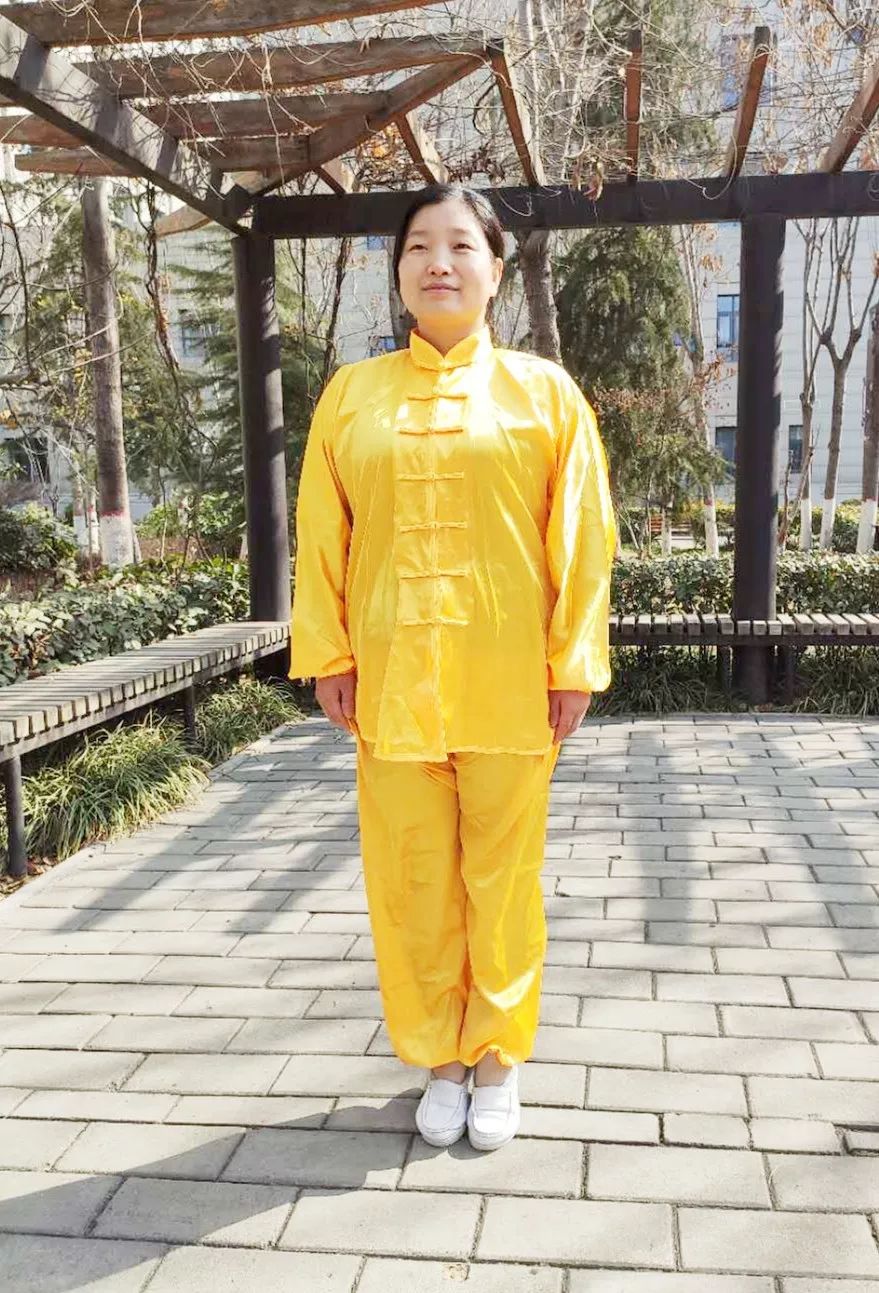
Effects and Principles:This movement primarily aims to vibrate the spine and the entire body, including the muscles, bones, and internal organs. The gentle vibrations combined with exhalation provide a beneficial stimulus to each organ, promoting the movement of the internal organs and invigorating the righteous qi. Tightening the anus, also known as the “contraction of the gu pathway”, can promote local blood circulation around the anus, preventing hemorrhoids and other perianal diseases. According to traditional Chinese medicine, inhaling while tightening the anus can elevate the body’s central qi, preventing the descent of central qi that can lead to organ prolapse. Additionally, gripping the ground with the toes can stimulate the relevant meridians on the feet, as the toes are where the three yin and three yang meridians intersect, stimulating these meridians can regulate the corresponding internal organs. Simultaneously, bouncing can stimulate the spine and Du Mai, ensuring smooth flow of qi and blood throughout the internal organs, achieving balance between yin and yang. Rising onto the toes can strengthen the muscles in the back of the calves, elongate the muscles and ligaments in the feet, and enhance balance. The impact of landing can lightly stimulate the internal and external structures of the joints in the lower limbs and spine, helping to relax and realign the muscles throughout the body, alleviating muscle tension.Baduanjin Qigong is simple in movements, diverse in forms, and effective, with low space requirements, making it suitable for various groups of people to practice. Consistent practice of Baduanjin can regulate the flow of qi and blood in the meridians, improve the functions of the internal organs, and achieve the effects of disease prevention and health promotion. As the saying goes, “When the righteous qi is stored within, evils cannot invade.” To better enhance our ability to resist diseases and collectively combat the pandemic, let us start practicing now!
Source: Acupuncture and Tuina Rehabilitation Department, Liu Xiaorong
Editor: Publicity Department, Hu Jia
Reviewed by: Acupuncture and Tuina Rehabilitation Department, An Junming

